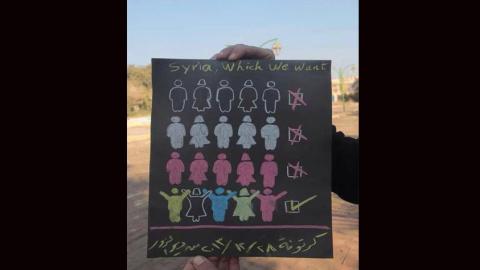The Syrian National Coalition (SNC) recently announced that the Islamic State in Iraq and Syria (ISIS) is a hostile organization to the Syrian uprising. Shortly after, the Free Syrian Army (FSA) launched a military campaign against the militia group and besieged its main headquarters in the village of al-Dana. This undoubtedly brings about a new phase in the complex history of Syria’s revolution. However, ISIS cancerous growth could not have happened without the inaction of the different political groups despite the popular unrest and awareness that such groups were growing stronger. Nevertheless, Syrians declared this a “second revolution”, against both tyrannies, that of Assad and of ISIS.
These latest developments, however, demand some reflection about how we ended up here. How were these organizations able to infiltrate the main body of the uprising? Was the regime involved in any way? If not, then who is behind them? Is it al-Qaeda or is it some intelligence service? And what about other radical Islamist groups, are they more moderate than ISIS, and thus acceptable, or are they just a different side to the same coin?
To explore these questions, Syria Untold has tried to dig up and sift through our vast archives of data and interviews with local activists over the course of the revolution.
From civil to Islamist
In an interview with a local activist close to the coordination committee of al-Midan neighborhood in Damascus, he talked to Syria Untold about the beginning of the end for the strictly nonviolent phase of the revolution in that area: “Civil nonviolent activism lasted until September 2011, when many of the core activists and coordination committee members were arrested by the regime.” This created a vacuum in the area which was filled with the help of activists from outside the neighborhood. At this time the mood started to shift and the civil activism was becoming mixed with celebrations of the FSA with some Islamic presence. This hybrid phase lasted until July 2012 when the FSA finally overtook the neighborhood in a failed attempt to storm the capital.
https://www.youtube.com/watch?v=MvHZ28-dvA8
After the regime’s forces retook the area from the FSA, many of the activists and coordination committee members were detained. This opened the stage to a completely new breed of Islamist activists who were able to gain significant funding from outside the area, in contrast to the earlier activist groups who were always struggling with funds.
Another activist, who worked as a doctor, concurred with this story of the events and observed that Islamist agendas were spreading within the revolution partly because of the regime’s brutality which served to lay fertile grounds for such ideologies, but mostly because of foreign funds. This funding became crucial for continuing resistance at beleaguered communities especially after the spiralling costs of living and medical supplies.
https://www.youtube.com/watch?v=WiVFgpLtB-0
The story repeats itself in the neighborhoods of Mazzeh and Kafr Sousa, albeit with a slightly different timeframe. The civil and nonviolent activism in these areas survived up until the end of 2012, after which it also became mixed with militaristic and Islamist sentiments. Gradually the civil elements of the movement retreated while the Islamist current took hold. An activist from the area explained that the civil movement survived much longer in the area due to the fact that “the coordination committees were, at all time, reliant on local activists who could hide in the large farmland adjacent to the neighborhoods. This allowed them to survive the many regime attacks on the area and retain the civil and nonviolent identity for much longer.”
Islamism takes over
Islamist agendas, however, were successful in many areas where core activists were detained, and material need meant that the funders’ agenda was imposed. This only served in splitting the ranks within the revolution, where many early revolutionaries refused to work under the banners and slogans of radical Islamists. This was combined with no real consideration given to the wellbeing of the areas that were constantly under pressure from the regime for providing shelter for the coordination committees and the military opposition. More ominously, in many of these areas, the focus of the local militias shifted from fighting the regime to establishing an “Islamist state.”
Since the beginning of 2013 Islamist agenda had overtaken the civil one as can be seen from the slogans at demonstrations, names of the new militias as well as names of the friday protests. In fact, an analysis of the names of the friday protests can easily reveal the growth of Islamist influence within the revolution. While the early names were more civic and secular in nature (e.g. Great Friday, Friday of Dignity, Friday of Azadi), the later ones were overtly Islamist in nature (e.g. Friday of our eternal leader, Muhammad).
This growth was never without resistance, however, and Syria Untold has reported on several stories of Syrians rebelling against their new tyranny. This has come a full circle with this week’s friday named “Friday of Rage against Assad and ISIS”.




